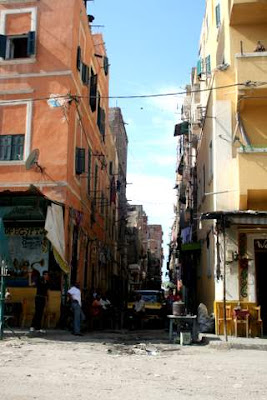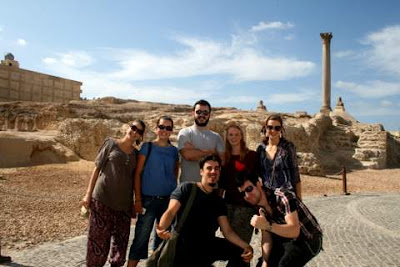The Catacombs in Alexandria, or Kom al Shu'afa, are located some distance away from our apartment in a somewhat run-down but extremely busy area of town. There are numerous entrances but one main spiral staircase leads down to the majority of accessible chambers, a labyrinth of dusty passageways and alcoves where the dead - presumably those of an elevated social/economic status, though it is not explained - were laid to rest below ground in stone sarcophagi. Photos are not permitted, and the few I take through bribery and sheer cheek are not really worth showing, but essentially we're looking at the early levels of Tomb Raider 4, complete with a guide almost as ancient as the place itself and a silence that after so long in the city is eerie and unexpected. Some rooms are high-ceilinged and airy, with shafts of light falling in white squares from the modern skylights; others are tiny and oppresive and can only be reached by intrepid short people. Good training for the pyramids perhaps.
While the majority of the catacombs are bare granite, some walls are still adorned with the original faded paintings and carvings of Egyptian gods - and, further on in the larger tombs, fragments of Roman mosaics. In one room a spectacular depiction of the mummification process while Anubis looks on is emblazoned on the wall above a huge stone burial niche. Elsewhere there is the 'banquet room' where the families of the deceased could gather for meals in the company of their loved ones.
The Catacombs were only discovered in the 1800s when, according to the guidebooks and a sign near the entrance to one of the tombs, a donkey literally fell through a weak section of pavement and opened up the hidden world beneath. In a room near the back of the available tombs, assembled in a glass case, is the skeleton of an animal without explanation. Although Egyptians were often buried with their pets and holy animals were occasionally mummified, we wonder if it might be the ill-fated but legendary beast of burden that led to this vast, accidental discovery.
It doesn't take long to look around and we move on to 'Pompey's Pillar', one of the best-known monuments still standing in Alexandria. It's a short walk away from the Catacombs through an area so stereotypically Arabic that the only thing my poor Western brain can compare it to is the fictional town in Team America. See below (some of my favourite pictures from our time here so far, apart from the rubbish dump):
Above: yet another bumper sticker captures the mood.
Below: happy faces following dirt-cheap date biscuits from a street vendor.
The pillar overlooks part of the ancient acropolis and was erected between 200 and 300AD, originally as part of a temple colonnade. Remnants of the old city surround it, including statues, the foundations of old buildings and a series of underground tunnels believed to have once housed the books that could not fit into the library. Two immense Sphinxes sit in front of the pillar, gazing out at the modern landscape.
That's all for now; more beachy goodness in days to come.











No comments:
Post a Comment